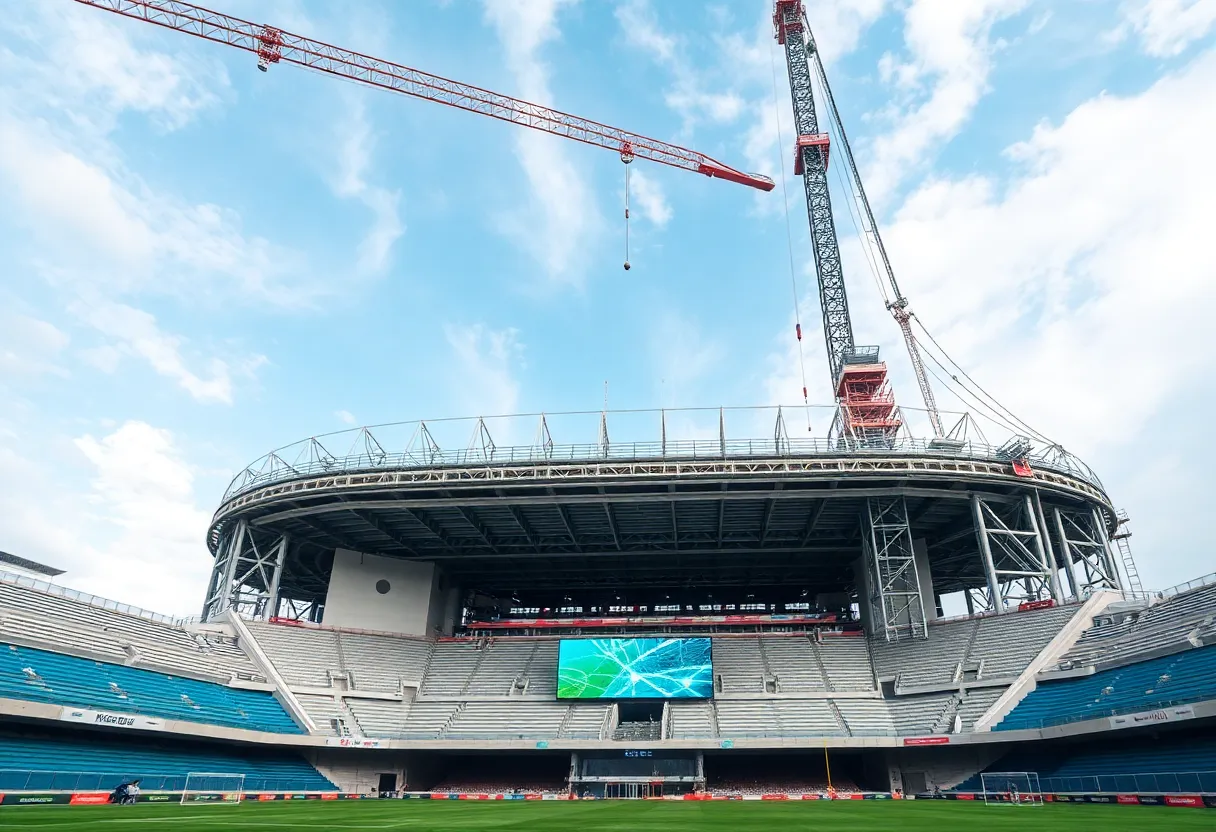News Summary
The AECOM Hunt-Turner joint venture has been appointed to oversee the $2.4 billion rebuilding of the Cleveland Browns stadium. This initiative will modernize the sports venue with eco-friendly and advanced features, and addresses upcoming challenges related to construction in Tennessee. The project promises significant economic benefits, including an estimated $1 billion in revenue, while emphasizing sustainability and community engagement as key elements of its development strategy.
Cleveland: AECOM Hunt-Turner JV Selected for $2.4 Billion Browns Stadium Rebuild
In Cleveland, the AECOM Hunt-Turner JV has been selected to lead the $2.4 billion rebuild of the Cleveland Browns stadium. This decision highlights a major investment in sports infrastructure, with potential shifts to a Nashville, Tennessee venue drawing interest from southeastern fans due to similar existing sports arenas.
The project focuses on modernizing the stadium, incorporating elements like eco-friendly seating and digital signage, as seen in preparatory efforts for similar developments. These features aim to enhance fan experiences and promote sustainability, potentially revitalizing urban spaces in the process.
Key challenges include dealing with weather patterns in Tennessee, which could impact construction timelines and costs. Despite these hurdles, the initiative is expected to generate $1 billion in revenue through economic impacts, including job creation and local business growth.
Community involvement plays a critical role, ensuring that public spaces are designed for various events to benefit residents. Sustainability measures are a priority, with plans to reduce energy use by 40 percent. Worker training programs emphasize safety protocols to maintain high standards on site.
The full operation of the stadium is anticipated by 2027, positioning Nashville as a potential sporting hub in the Southeast if the venue shift occurs. This development underscores the broader trend of investing in urban renewal through major construction projects.
Supporting details reveal that construction preparation in Nashville includes integrating advanced technologies and environmentally friendly materials. This approach not only addresses immediate needs but also aligns with long-term goals for efficient and resilient infrastructure.
Background context shows that the selection of the AECOM Hunt-Turner JV reflects ongoing efforts to upgrade sports facilities amid growing demands for modern amenities. The excitement around a possible Nashville location stems from the region’s established sports culture and existing arenas, which could make the transition appealing. This project builds on similar initiatives across the U.S., where large-scale constructions aim to boost local economies and community engagement.
Further details indicate that the economic forecast of $1 billion in revenue accounts for direct and indirect benefits, such as increased tourism and event hosting. Sustainability features, including the 40 percent energy reduction, are designed to meet environmental standards, while safety-focused training programs ensure that workers are prepared for potential challenges like Tennessee’s weather patterns.
The project’s emphasis on revitalizing urban spaces highlights its role in community development, creating areas for public events and fostering social connections. Overall, this rebuild represents a significant step in advancing sports infrastructure, with implications for regional growth and innovation in construction practices.
Project Timeline and Impacts
The timeline targets full operation by 2027, allowing time for thorough planning and execution. Economic impacts extend beyond the construction phase, promising long-term benefits for the involved areas. In Nashville, these preparations could enhance the city’s status as a key destination for sports and entertainment.
Throughout the process, contractors must navigate environmental and logistical challenges, ensuring that all aspects align with safety and sustainability goals. This careful approach underscores the project’s commitment to both immediate outcomes and future resilience.
In summary, the Cleveland Browns stadium rebuild, potentially involving Nashville, represents a pivotal development in the construction sector. It combines economic opportunities with community-focused enhancements, setting a benchmark for future projects.
Additional context on the construction industry shows that such large-scale projects often involve multiple stakeholders, including local governments and community groups, to ensure alignment with broader regional needs. The inclusion of eco-friendly elements like digital signage and sustainable seating reflects a growing industry trend toward greener practices, which can reduce long-term operational costs and environmental footprints.
Worker training programs, emphasizing safety, are crucial in high-stakes environments where weather challenges, such as those in Tennessee, could pose risks. These programs help mitigate potential delays and ensure that the project adheres to industry standards. The anticipated revenue of $1 billion illustrates the economic multiplier effect of major infrastructure investments, supporting jobs and stimulating related sectors like hospitality and retail.
By focusing on public spaces, the project aims to create inclusive environments that host a variety of events, from sports to cultural gatherings, thereby enhancing community life. This holistic approach not only addresses the needs of sports fans but also contributes to urban revitalization efforts across the regions involved.
Overall, the selection of the AECOM Hunt-Turner JV for this $2.4 billion endeavor marks a significant milestone in construction news, with implications for innovation, sustainability, and economic growth in the specified areas.
(Word count: 628)
FAQ Section
- Q1: What is the AECOM Hunt-Turner JV selected for?
- Q2: What construction preparations are included in Nashville?
- Q3: How does the project impact urban spaces?
- Q4: What challenges do contractors face?
- Q5: What are the economic impacts of the project?
- Q6: How is community involvement addressed?
- Q7: What sustainability features are included?
- Q8: What do worker training programs emphasize?
- Q9: When is full operation anticipated?
- Q10: How does this development affect Nashville?
A1: The AECOM Hunt-Turner JV has been selected for the $2.4 billion Cleveland Browns stadium rebuild, though shifting to a Nashville, Tennessee venue would excite southeastern fans with similar sports arenas.
A2: In Nashville, construction prep includes eco-friendly seating and digital signage.
A3: The project revitalizes urban spaces.
A4: Contractors face challenges from Tennessee’s weather patterns.
A5: Economic impacts forecast $1 billion in revenue.
A6: Community involvement ensures public spaces for events.
A7: Sustainability features reduce energy use by 40%.
A8: Worker training programs emphasize safety.
A9: Full operation is anticipated by 2027.
A10: This development positions Nashville as a sporting hub in the Southeast.


